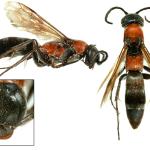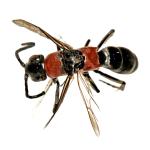Records of this wasp are confined to a small number of heathland sites in southern England. In Dorset it has been found at Southaven (1935), Furzebrook (1943), Morden Heath (1956) and Tadnoll Heath (1962). Hampshire records are confined to a forest path between Holiday Hill and Emery Down, New Forest (1900) (Saunders 1900) and Cranes Moor, near Burley (1990) (Else 1992b). Surrey records are all old: Holmwood (1907), Chobham (1914) and Woking (1941).
Listed as Endangered (RDB1) in Shirt (1987) and Falk (1991).
Day, 1988 is the standard work for identifying British Pompilidae. Wiśniowski, B., 2009 is also useful.
Usually collected by sweeping low vegetation, though G R Else's record was of a male running over a sandy heathland path.
Adults have been found from June to August.
It is clear from the literature that this is an extremely elusive species, and it is possible that rearing the wasp from host webs might be a more effective way of recording it than searching for adults. The life history has been studied on the Continent (Richards & Hamm, 1939; Day, 1988). Here, the wasp attacks females of the spider Cheiracanthium erraticum (Clubionidae) within their characteristic webs, which are usually constructed in rolled-up leaves or flower heads of grasses. The wasp does not produce a nest of its own and has a morphology which allows it to squeeze through the host's web. Parasitised spiders do not appear to lay eggs but are quite active and will react to disturbance. The spider dies about 11 days after the pompilid larva hatches, by which time it has been sucked dry. In France, Maneval (1936) reports finding early stages of Homonotus in four-fifths of C. erraticum webs, despite seeing only one adult.
The species was collected by G M Spooner on wild carrot and either yarrow or sneezewort at Tadnoll, Dorset (S P M Roberts, pers. comm.).
1997



